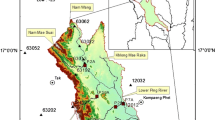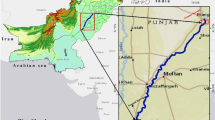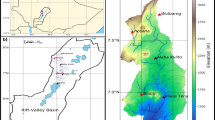Abstract
The present study was carried out to identify the extent of flood hazard on the Fogera floodplain in the Ribb catchment of the Blue Nile River basin in Ethiopia. A coupled 1 dimensional (D) and 2D hydrodynamic model (i.e., MIKE FLOOD) was used to simulate the flood inundation extent and flooding depth under climate change scenario in the study area. MIKE FLOOD coupled with a SWAT was used to simulate the floods hazard maps under short-term (2030s) and long-term (the 2060s) future climate projections for the RCP4.5 scenario. The results were revealed that the future minimum and maximum temperature can be increased to 1.99 °C and 2.65 °C, respectively. The average annual rainfall can be increased in the future. The dimensionless inflow hydrograph was best fitted with Gumbel distribution for the 100 years return period. This was derived from an output of the hydrological model and then fed into MIKE FLOOD to generate the flood hazard maps. The intensity of annual floods was indicated an increasing trend under the RCP4.5 scenario. The model was calibrated using the historical hydro-meteorological data, measured River cross-section data, and Lake Tana water level. The result of flood frequency analysis showed that a flow value of 100 year return period can be expected to 290 m3/s, 346 m3/s, and 367 m3/s for historical, short-term, and long-term time periods, respectively. The prepared flood hazard map indicated that the flooded area can be expected to 57.72 km2, 59.3 km2, and 61.01 km2 for the base period, 2030s, and 2060s, respectively, while the depth of inundated flood flow in the study area may be anticipated to a depth of 4.23 m, 4.68 m, and 4.96 m for similar time periods, respectively. Therefore, this study will be helpful for the decision makers to take the decision about the planning for the flood mitigation measures in the study region.












Similar content being viewed by others
References
Abbaspour KC (2015) User manual for SWAT-CUP, SWAT calibration and uncertainty analysis programs. Swiss Federal Institute of Aquatic Science and Technology, Eawag, Duebendorf, Switzerland p 103
Abera Z (2011) Flood mapping and modeling on Fogera flood plain: a case study of Ribb River (Doctoral Dissertation, aau)
BCEOM (Egis Bceom International) (1999) Abbay River Basin Integrated Development Master Plan Project and Associates (1999); Abbay Basin Integrated Development Master Plan Project; Phase 2, Section II, Vol. III: Water Resources: Part 1 – Climatology and Part 2–Hydrology
Brath A, Montanari A, Moretti G (2006) Assessing the effect on flood frequency of land use change via hydrological simulation (with uncertainty). J Hydrol 324(1–4):141–153
Chaemiso SE, Abebe A, Pingale SM (2016) Assessment of the impact of climate change on surface hydrological processes using SWAT: a case study of Omo-Gibe river basin, Ethiopia. Model Earth Syst Environ 2:1–15. https://doi.org/10.1007/s40808-016-0257-9
Dandapat K, Panda GK (2017) Flood vulnerability analysis and risk assessment using analytical hierarchy process. Model Earth Syst Environ 3:1627–1646. https://doi.org/10.1007/s40808-017-0388-7
Davies T, McSaveney M (2011) Bedload sediment flux and flood risk management in New Zealand. J Hydrol 50(1):181
DHI (2016) MIKE-21, User guide, Danish Hydraulic Institute
EM-DAT CRED (2012) The International Disaster Database
Endalkachew B et al (2004) Generation and application of climate information, products and Services for disaster preparedness and sustainable development in Ethiopia, Addis Ababa, Ethiopia
Graham LP (2004) Climate change effects on river flow to the Baltic Sea. AMBIO J Hum Environ 33(4):235–241
Hirabayashi Y, Kanae S, Emori S, Oki T, Kimoto M (2008) Global projections of changing risks of floods and droughts in a changing climate. Hydrol Sci J 53(4):754–772
Hussen B, Mekonnen A, Pingale SM (2018) Integrated water resources management under climate change scenarios in the sub-basin of Abaya-Chamo, Ethiopia. Model Earth Syst Environ 4:221–240. https://doi.org/10.1007/s40808-018-0438-9
Kadam P, Sen D (2012) Flood inundation simulation in Ajoy River using MIKE-FLOOD. ISH J Hydraul Eng 18(2):129–141
Leander R, Buishand TA (2007) Resampling of regional climate model output for the simulation of extreme river flows. J Hydrol 332(3):487–496
Lenhart T, Eckhardt K, Fohrer N, Frede H-G (2002) Comparison of two different approaches of sensitivity analysis. Phys Chem Earth, Parts A/B/C 27:645–654. https://doi.org/10.1016/S1474-7065(02)00049-9
MIKE Zero (2016) User manual, Danish Hydraulic Institute
Moriasi DN, Arnold JG, VanLiew MW (2007) Model evaluation guidelines for systematic quantification of accuracy in watershed simulations. Trans ASABE 50:885–900
NMA (2007) Climate Change National Adaptation Program of Action (NAPA) of Ethiopia country report. Addis Ababa, Ethiopia
Prudhomme C, Wilby RL, Crooks S, Kay AL, Reynard NS (2010) Scenario-neutral approach to climate change impact studies: application to flood risk. J Hydrol 390(3):198–209
Santhi C, Arnold JG, Williams JR, Dugas WA, Srinivasan R, Hauck LM (2001) Validation of the Swat model on a large Rwer Basin with point and nonpoint sources. J Am Water Resour Assoc 37:1169–1188. https://doi.org/10.1111/j.1752-1688.2001.tb03630.x
Setyorini A, Khare D, Pingale SM (2017) Simulating the impact of land use/land cover change and climate variability on watershed hydrology in the Upper Brantas basin, Indonesia. Appl Geomatics 9. https://doi.org/10.1007/s12518-017-0193-z
Shrestha S, Lohpaisankrit W (2016) Flood hazard assessment under climate change scenarios in the Yang River Basin, Thailand. Int J Sustain Built Environ
Tarekegn TH, Haile AT, Rientjes T, Reggiani P, Alkema D (2010) Assessment of an ASTER-generated DEM for 2D hydrodynamic flood modeling. Int J Appl Earth Observ Geo Inform 12(6):457–465
United Nation Office for the Coordination of Humanitarian Affairs (UNOCHA) (2006) Focus on Ethiopia: a monthly focus on humanitarian trends and activities in Ethiopia. Addis Ababa
Van Griensven A, Bauwens W (2003) Multi objective auto calibration for semi distributed water quality models. Water Resour Res 39(12):1348. https://doi.org/10.1029/2003WR002284
van Vuuren DP, Edmonds J, Kainuma M, Riahi K, Thomson A, Hibbard K, Hurtt GC, Kram T, Krey V, Lamarque JF, Masui T, Meinshausen M, Nakicenovic N, Smith SJ, Rose SK (2011) The representative concentration pathways: an overview. Clim Chang 109:5–31. https://doi.org/10.1007/s10584-011-0148-z
Acknowledgments
We gratefully acknowledge the DHI to provide student license for MIKE FLOOD application. We thankfully acknowledge the reviewer and editor for their constructive comments which increase the quality of the paper.
Author information
Authors and Affiliations
Corresponding author
Electronic supplementary material
ESM 1
(DOCX 1162 kb)
Rights and permissions
About this article
Cite this article
Robi, M.A., Abebe, A. & Pingale, S.M. Flood hazard mapping under a climate change scenario in a Ribb catchment of Blue Nile River basin, Ethiopia. Appl Geomat 11, 147–160 (2019). https://doi.org/10.1007/s12518-018-0249-8
Received:
Accepted:
Published:
Issue Date:
DOI: https://doi.org/10.1007/s12518-018-0249-8




